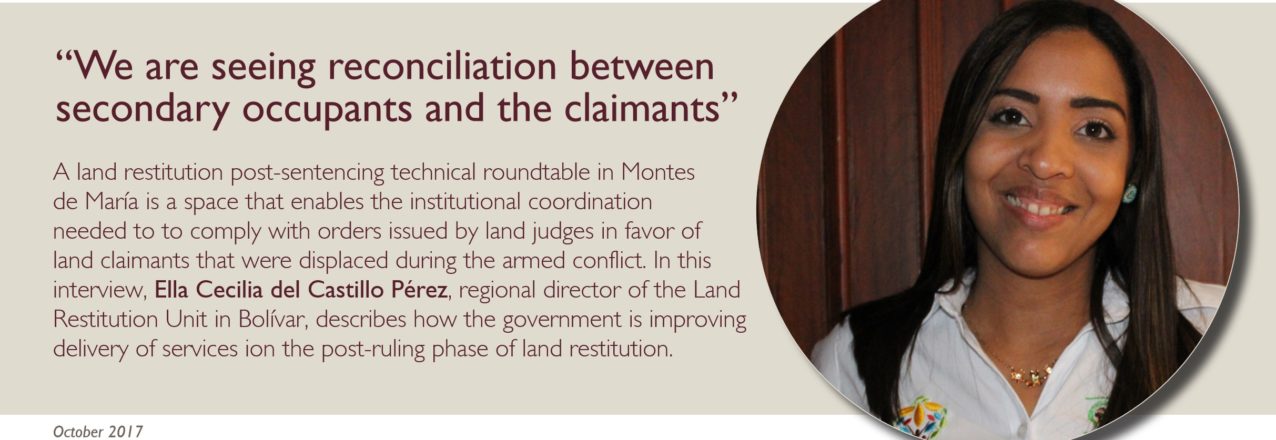In Bolívar, the government has received 5,972 land restitution requests, and 93% of those have are in process or have been answered. In this moment, there are 1,104 demands—corresponding to approximately 16,000 hectares—in the hands of land restitution judges and magistrates. In Bolívar, nearly 5,400 hectares have been restituted. This corresponds to 205 individual and collective rulings, representing approximately 380 families. Some 60% of the rulings are in the course of implementation, and 40% of the cases are pending material delivery.
One of the pitfalls in the implementation of restitution orders has to do with secondary occupants and the ability to vacate the land inhabited by a secondary occupant in order to deliver the land to the claimant. How have you solved this?
In the department of Bolívar, we have been pioneers in this issue of second occupants and in practice we have created new paths. Along with Sucre, we are the two regions with the most cases of secondary occupants. We have sought solutions together with the other institutions involved, including the restitution judges. We have managed to avoid forced eviction, rather for judges to convene preparatory hearings where all the entities are present, and we generate short-term commitments that will help the secondary occupant. This must happen before there is any recognition of ownership of a property where we know that there is a secondary occupant. If we don’t do this, a very complex situation is likely to unfold. We are trying to adopt practices that mitigate the amount of collateral damage and avoid that the secondary occupants are re-victimized. We also count on the support of regional authorities that assume many of the tasks necessary for the accommodation and transfer of the people, but the ultimate goal of this exercise is that there are no forced evictions and that our restitution work does not causes further damage or negative impacts upon our communities.
Do joint spaces such as the post-sentencing technical roundtable enable the LRU and government partners to address issues such as secondary occupants and order compliance?
Yes, these spaces have been fundamental in terms of coordination between the institutions that are involved in land restitution, because together we can better identify bottlenecks and problematic situations preventing compliance and delivery. In these spaces, we have achieved significant coordination with the judges on the issue of secondary occupants and the compliance of delivering the property in question to the original owner. In addition, the LRU has been developing a methodology involving a series of visits along with the judges so that the relevant entities can comply with the ruling’s orders that favor the secondary occupant, who will be leaving the land. This methodology has provided excellent results, and there are recent cases in which we have seen valuable experiences of reconciliation between the second occupant and the claimant.
Is there an example of reconciliation that you could highlight?
We recently had a case of a claimant named Gloria Caro, a woman victim of the conflict, and the secondary occupant, a vulnerable farmer in the township of El Salado. The farmer was legally recognized as a secondary occupant and was granted a productive project that he could implement on another plot of land that he had. There, we found a very nice act of reconciliation, because the claimant and the secondary occupant shook hands. Both parties received benefits from the government
through the land restitution policy. A happy ending.
Did coordination play an important role in this case?
These coordination roundtables are very important scenarios in order to ensure that entities speak the same language in terms of secondary occupants. In this specific case, we were able to showcase the methodology we are using for secondary occupants and we found a very good response from the judges who adapt to the characterizations and issue the orders that benefit the secondary occupant.
What are examples of other bottlenecks that you have identified thanks to the roundtable?
Many of these bottlenecks have to do with the coordination with judges in the accuracy of a sentence’s orders. This has led us at the LRU to revise how the claims’ requests were being developed, so that judges could be more consistent and clear in issuing enforceable orders. In some cases, the orders were very abstract, poorly directed, and in that vein, their enforcement became complicated. Another aspect is the access to information by the judges, particularly the fact that there was no real-time access to institutional information required for the rulings. In that sense, progress has been made in the Land Node, a system created with USAID’s support, which will soon be available to judges.
What has been achieved from the technical roundtable in terms of the mobilization of resources in the municipalities in favor of the victims?
USAID has been pushing the issue of the mobilization of resources, namely in El Carmen de Bolívar, so that the Municipality can also move resources that it has earmarked for the land restitution process. We have also learned and begun coordinating within the municipal development plan, which has a number of components relating to the issue of secondary occupants. The work coordinated and managed by USAID has enabled us to achieve speed, knowledge, and even to improve relations between the LRU and the local government.
How has the monitoring of compliance with the ruling orders been strengthened?
In these inter-agency roundtables, the Ombudsman’s Office and the Office of the Inspector General of the Nation is always present. We work in close relationship with these entities in order to closely monitor the fulfillment of orders and use whatever capabilities each entity has to improve the compliance of restitution rulings.


